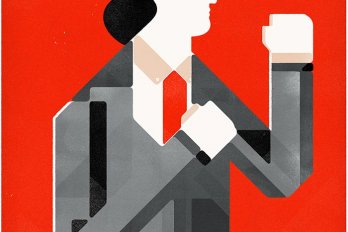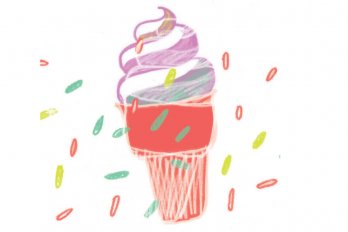All great fighters are in love with the epic, so classics scholars will forgive Georges St-Pierre for declaring his intention, with his new quasi-memoir, The Way of the Fight, “to write the greatest book ever written.” The Ultimate Fighting Championship welterweight titleholder from Saint-Isidore, Quebec, puts in a game effort, but 200 pages later Homer will not have conceded. Which is not to say the tale lacks mythic overtones: a boy is bullied, fights back, discovers his power, finds a master, faces tests, conquers himself and his opponents, then returns to impart his wisdom.
It’s the “faces tests, conquers himself” portion of the hero’s journey that concerns The Way of the Fight. Eschewing the standard chronology of biography in favour of something akin to self-help, St-Pierre alternates anecdotes about his ascent out of schoolyard shrimpdom with insights gleaned from St. Augustine, the Kill Bill films, and the evolutionary path of the cockroach. This mixed literary art parallels his sport, which shifts terrain like Odysseus en route to Ithaca, and borrows, in rough order of influence, from jiu-jitsu, kick-boxing, wrestling, karate, judo, tae kwon do, and homoerotic art.
Known as Gentleman Georges, St-Pierre is honest and intelligent about mixed martial arts, and about his position within the sport. Undefeated for six years, he stands above Tommy Burns, George Chuvalo, and Lennox Lewis as Canada’s greatest professional fighter. His main subject, in this book, is fear: the fear fighters face on their path to becoming great, and by extension the fear we all face in our daily lives.
Those who find MMA savage might wonder why a fighter would spend so much time dwelling on fear. On the surface, it’s obvious. After signing on for a fight, each athlete spends months training for the moment when he finds himself on his back with another man’s thinly gloved fists driving toward his skull with the aim of making Pablum; this for the pleasure of millions of witnesses who will soon forget him should he lose. St-Pierre doesn’t dwell much on the dangers, however, tending instead to the Yodaesque: “The present loses its power when pitted against fear,” he writes in one of countless such examples. The way of the fight, it seems, is a constant process of self-confrontation.
But St-Pierre is too guarded, or too savvy, to give away much. “Some of my fears are terrorizing, paralyzing,” he writes, and then dances away: “I won’t talk to you about those.” He alludes briefly to spending time in prayer, to his reclusiveness in the weeks before a fight, to the emotion of the ring, but always in the broadest of terms. Only in brief, rare windows does The Way of the Fight suggest what that way means for many: less a benign, teachable process of personal growth than something fuelled by an existential ache.
As a young, newly popular fight sport, MMA has yet to produce a literature that dives deeply into its participants’ psyches. In this, it contrasts sharply with boxing, which has seen centuries of wild characters, warrior-philosophers, and scribes in tow to document them. Some of the best journalists and stylists of the twentieth century were compelled to write about the sport: A.J. Liebling wrote dozens of boxing features for The New Yorker; George Plimpton went three rounds with Archie Moore for Sports Illustrated; Norman Mailer pitted his stylistic bombast against Muhammad Ali’s in The Fight. Above the boys stands Joyce Carol Oates, whose 1987 essay “On Boxing” captures all the pathos, intensity, and beauty of the sport, in full awareness of its moral complexity but without apology for the author’s fascination. “The boxers will bring to the fight everything that is themselves,” she writes, “and everything will be exposed—including secrets about themselves they cannot fully realize.”
South African author Donald McRae sought to probe those secrets for his 1996 book, Dark Trade: Lost in Boxing. For nearly a decade, he dug into what drove a handful of British and American boxers to excel at a sport they knew could kill them. He found, curiously, that many had grappled at a formative age with some other, more powerful fear. For Roy Jones Jr., it was of Roy Jones Sr.; for Prince Naseem, of racist bullying. The Rosebud moment for Mike Tyson, one of the sport’s most dramatic figures, came when he pulverized a bully after the boy snapped the neck of one of Tyson’s pet pigeons.
For many, underlying these traumas was a feeling of powerlessness often born of poverty and family breakdown. “I was thinking only of survival—and boxing offered something more than that,” Tyson told McRae. “If it hadn’t been for boxing, I’d have wound up a long time ago in jail or even dead.” Soon afterward, Tyson would be charged with rape, for which he spent three years in prison. When he came out, his troubles continued: he became a laughingstock for twice biting an opponent’s ear during a championship bout, went bankrupt, and became an addict before lately enjoying a moment of public redemption.
The drive from poverty to the ring also held true for Floyd Patterson. In 1956, at age twenty-one, he knocked out Archie Moore, becoming the world’s youngest heavyweight champion. Unlike Tyson, whose reputation was founded on intimidation, he was open about the extent to which his fears drove him. “Patterson would describe his dreams, the depths of his fear,” wrote The New Yorker’s David Remnick. “He talked and talked, one of the great analysands of the prize ring.” Often these conversations were with Esquire’s Gay Talese, whose seminal 1964 profile, “The Loser,” detailed Patterson’s inability to look men in the eye before fights, and the extreme lengths to which he went to hide from the public in the wake of his defeats.
“You must wonder what makes a man do things like this,” Patterson said. “I have figured out that part of the reason I do the things I do, and cannot seem to conquer that one word—myself—is because… is because… I am a coward.” So why, Talese asked, had he chosen to fight if he was afraid? Why that in particular? “When you’re hungry, you’re not choosy, and so I chose the thing that was closest to me,” Patterson replied. “What were the requirements? Sacrifice. That’s all. To anybody who comes from Bedford-Stuyvesant in Brooklyn, sacrifice comes easy.”
Such naked need leaves fighters vulnerable to exploitation. In 1996, British scholar John Sugden published a study showing the intertwined histories of prizefighting and male economic insecurity. When boxing was codified, during the Industrial Revolution, prizefighting deaths had become commonplace. “The naked brutality of such contests and the obvious risks to the combatants begs the question why would anybody take part? ” Sugden wrote. “Entire districts consisted of filthy slums, demoralised by crime, congestion, disease and prostitution. It was from such pre-industrial ghettos that the vast majority of prize fighters came.” He suggests, too, the echoes of this relationship in the settling of feudal conflicts in proxy fights, and the sport and gladiatorial combat of antiquity, where participants often came to arenas hungry and afraid, for the chance at a fraction of the pie dangled before them by more powerful men.
No critic has written more damningly of this mentality than Gerald Early. In his 1989 essay “Ringworld,” he expresses admiration for the talented boxers he knew who had emerged from Philadelphia street gangs, and denounces the corrupt promoters who exploited them and the surrounding society that would have left them to languish in jail were it not for their ability to entertain wealthy white men. Arguing against calls for bans on boxing, he writes, “I think it is fitting to have professional boxing in America as a moral eyesore: the sport and symbol of human waste in a culture that worships its ability to squander.” Perhaps, he suggests, fight sports are not testaments to their champions’ sacrifice and heroism, but to the deep fears of disempowered men that their lives would otherwise amount to nothing.
If, as Early concludes, professional boxing is “capitalism’s psychotic vision,” mixed martial arts is that vision on clozapine. Where the business of boxing has long been a morass of commissions, promotions, and media, all seeking their slice of a talented fighter, top-level MMA in North America is the sole domain of the Ultimate Fighting Championship (run since 2001 by Dana White) and its parent company, Las Vegas–based Zuffa. The control UFC imposes has had benefits: there is only one champion for each weight class, for example, and model representatives of the sport are well taken care of. More questionably, Zuffa has spent lavish sums to lobby balky jurisdictions to legalize MMA; it is deeply in bed with the notoriously shady nutritional supplement industry; and it tightly controls contract negotiations, potentially preventing some talented fighters from earning their true worth.
UFC’s constrictive and corporatized culture has also helped to leave its fighters largely impervious to artistic treatment. (Even Homer would struggle to lyricize a battle called UFC 158.) In his narratives of fear, St-Pierre relies on the familiar echoes of Rocky, of Patterson and the rest. Going into his first UFC bout, in Las Vegas in 2004, he had been working joe jobs to fund his training. At one point during the match, his opponent, the favourite, locked his arm in a kimura hold, which often forces submission. “I knew my own truth, my life situation,” St-Pierre writes. “If I didn’t win, I couldn’t live to the end of the month.” An adrenaline surge struck, and he escaped the hold, then reversed his opponent en route to winning a decision.
He may have been exaggerating his need (he appears to come from a supportive family) but in the telling the achievement comes to seem greater. ’Tis harder to have feared and fought than never to have feared at all. The telling also, of course, makes the achievement more saleable, for which he can perhaps thank his co-author, a marketing expert named Justin Kingsley. For their story’s marketability, the writers owe thanks to the fighters who experienced fears St-Pierre has not, and who thereby created his template. From them, we see that for fighters the confrontation of fear is indeed universal. But for the fortunate ones, the way of the fight is a choice—to be pursued, if not in the Octagon, then in the boardroom, or the backroom, or in books—while for others, it is to be at the fight’s mercy. In Book Ten of the Iliad, Odysseus and Diomedes capture Dolon, a Trojan scout. “Take courage,” Odysseus says, “let not death be in thy mind.” Then Dolon tells them what he knows, and they slay him.
This appeared in the July/August 2013 issue.




